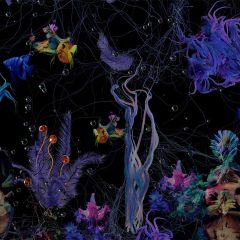
Most of us in Philadelphia haven’t heard of it, but Artomatic is a big deal in Washington DC. It’s an indoor art fair entirely run by artists, both visual and performing. About one thousand are participating in this year’s edition, which is billed as “Artomatic 25” since it has been 25 years since the first event took place.The fair, up to April 28, 2024, fills an eight-story office building right in downtown DC (at 2100 M Street), which has been vacant for five years. The building owners are lending it to Artomatic rent-free. In total, the area being used for exhibitions and performances is about 330,000 square feet.
We went to Artomatic because we were invited to participate on a panel (one of hundreds of events taking place during the seven-week run of the fair), and we were astonished by the size, the level of organization, the diversity and quality of much of the work on exhibition. Plus, it had a great vibe. The building’s corridors and open-plan spaces were full of artists and visitors all day long and well into the night; musical performances were taking place in several venues; three bars and an eatery (a pop-up of the well-known DC restaurant Busboys and Poets) were crowded, as was the “merch” store.

How Artomatic works
The artists who work in wall-hung media (painting, prints, photography, etc.) have a full or half display room (former offices with their doors removed). They had two weeks prior to the opening for installation, including modifying the rooms to suit their preferences (wall color, floor coverings and furniture). Most of the rooms were quite inviting. Other artists, many of whom created large-scale free-standing sculptures or installations, were given spaces in the open-plan parts of the building. Cost to participate was $150 per artist plus a commitment to do three 5-hour volunteer sessions (more about this later).
Artomatic is not just the name of the periodic art fair; it is the name of the arts nonprofit organization that came up with the idea. It remains active between fairs, interfacing with the property development sector and planning for the next fair, and handles logistics during fairs. It developed out of a number of DC-area artist groups that had been running co-op galleries and studios and wanted to try something bigger and bolder. Its philosophy is simple: participation is open to all; building community is paramount; artists are in charge (and have among them all the skills necessary to make it work); everyone involved must contribute “time and treasure”; everyone involved must respect everyone else involved, and artists must be open to feedback from their audiences.
Origins of the Fair
The first Artomatic took place in 1999, in the historic “Manhattan Laundry” complex in Northwest DC. The name Art-O-Matic was coined to suggest spontaneity and to play off the term “laundromat.” (The hyphens were dropped in 2004.) Through a friend-to-friend chain (pre social media!) the large space was filled with exhibiting artists and more than 25,000 viewers attended during the six-week run. The event made a splash in the DC area media and, as a supportive gesture, the D.C. Commission on the Arts and Humanities bought $25,000 in works from the show to put on permanent display in public buildings around the city. Subsequent Artomatics took place roughly every two years through 2017, after which there was a seven-year gap until this year’s version (partly due to the pandemic). Attendance at the fairs has been averaging over 40,000. Buildings provided by their owners have included a former Hechinger hardware store, a former government building, a former museum complex, and various former or newly built office buildings (including several just outside of DC, in Crystal City, Virginia). This year’s Artomatic has the largest building and the largest number of participants so far, so they are hoping for its largest attendance.

There are also by-invitation and international components of the fair. A large part of one floor was given to artists from Africa, Cuba, Romania, Moldova and Ukraine (and a separate space was set aside for a show about the war in Ukraine, which included artwork by Ukrainian children). We were given a wall on which to exhibit a set of “CETA Arts Legacy” banners, in advance of the discussion panel we led. Many of the large walls facing onto open spaces were reserved for murals that would be expressly created for Automatic. DC area mural artists were invited to submit proposals; those accepted had the three-week pre-opening period in which to execute their murals; paints were supplied by Artomatic.

An Excellent art-looking experience
The work on display, both in the individual room spaces and in the open-plan spaces, represented a dizzying variety of genres, styles and subjects, ranging from gloriously colorful and expressive to highly controlled and precise. There was a huge gamut of materials and concepts and, frankly, a wide range of evident skill. But, given that we saw work by several hundred artists in the two afternoons that we navigated the fair, we had an excellent art-looking experience overall.
One participating artist we found particularly intriguing was photographer Colin Winterbottom, who documents architectural restoration and had some astounding images on display. His exhibition, interestingly, had an added layer of meaning: it was hung in the very room that had been his office thirty years ago, before he began his photographic career. He had worked for one of the building’s previous tenants, the Urban Institute, which conducts economic and social policy research. He set up a desk in the room just as it would have been when he worked there, complete with a weekly calendar and copies of various research studies he had authored. At the entrance was his office name plate, just as it had been in 1996.

One of the reasons we had a very special experience in visiting Artomatic is that we were given a personal orientation by its president and promoter-in-chief, George Koch. In a previous career, in the 1970s, George worked as a program analyst at the U.S. Department of Labor. He became the key figure in DC in terms of using Comprehensive Employment and Training Act (CETA) funding to employ artists through a program that he created called Arts DC. During the 1990s, George, also an artist, was involved with several artist collectives and cooperative exhibition ventures. These eventually gave rise to Artomatic, and George became the first president of both the group and the 1999 initial art fair. He has had a leadership role in the organization ever since and has been its primary ambassador to the area’s real estate development community. For this Artomatic 25 edition, he once again stepped up and was elected president, although he is now in his mid-eighties!

Artomatic in Philadelphia?
Whether an Artomatic could be staged in Philadelphia is an intriguing question. The group has a complete DIY guide available, and would be happy to license the concept and name in furtherance of their mission to develop community among artists. Certainly, there are many empty or under-occupied buildings in Philadelphia. (As it happens, the development firm that owns the building housing Artomatic in DC is Post Brothers, which is Philadelphia based.) There is a large creative community in Philadelphia that might embrace the concept. But carrying out an Artomatic isn’t easy. First and foremost, a large, dedicated and broadly skilled set of members and volunteers would be required. The DC Artomatic group was first given access to their space six months ago, and there was a tremendous amount of work to be done to make the long-vacant building usable again, repairing HVAC, plumbing and electric systems, getting some of the elevators running, and removing doors and office furniture from the rooms. During the fair itself, volunteers work in jobs ranging from security to bartending to running/staffing a gift store. They also act as press representatives and oversee the website and social media. While it would certainly be a challenge, holding an Artomatic (or something very similar) in Philadelphia could be quite an exhilarating experience for our cultural community.
If we’ve peaked your interest and you’d like to see Artomatic for yourself, it will be open through April 28. Go to their website for full information.
Read some more Artblog articles by Blaise Tobia and Virginia Maksymowicz.
Read about the CETA program









